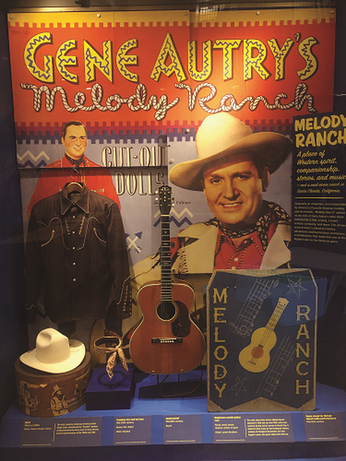The Autry Museum of the American West

Although his Western yarns were wildly successful with audiences, Autry knew that the contrived “Hollywood on horseback” tales were not authentic depictions of life in the Old West. He dreamed of an institution that would not only tell the true stories but also preserve the art, history and diverse cultures of the American West. He enlisted his wife, Jackie, and friends, Joanne and Monty Hale, a fellow B-Western actor and musician, to help make his vision a reality.
“My husband had a dream to educate people about the history of the West,” says Jackie Autry. “Building that facility to express his beliefs came late in his life, so he left it to people, like myself and others, to build a facility that would express what the history of the West was — not what it is today, but what it was. That’s what he wanted to do. That was his dream.”
From the ground up
In 1986, the city of Los Angeles granted the proposed museum a $1 per year, 65-year lease on 13 acres of land in Griffith Park across from the Los Angeles Zoo. Previously a construction dump used while building the nearby Golden State Freeway, the site required extensive cleanup before construction could begin. Tom Bradley, the mayor of Los Angeles at the time, was a champion of the museum and helped expedite permits and the construction of the new facility.
With the future site and building plans in place, Jackie Autry and Joanne Hale began to build a world-class collection of art and artifacts for the new museum. Through gifts, donations, auctions and purchases of collections, they acquired paintings, sculptures, costumes, textiles, firearms, tools, toys, musical instruments, and other objects that would help tell the stories of the nascent museum. They quickly realized that many folks claimed to have genuine articles from the old West, but often lacked the proper paperwork or photographs to establish museum-worthy provenance of the items. “If a museum can’t validate [an artifact] with unquestionable certainty, they cannot display it,” says Jackie.
Construction of the new facility took two years. “We built a museum that no one in the museum industry had ever seen before,” asserts Jackie, explaining the then state-of-the-art security and fire suppressant systems in the new building. “We had people and other museums, including the National Gallery, come from all over to look at our museum so they could learn from what we did.”

Exploring the Autry
The fascinating history of America’s West comes to life for children and adults alike through a variety of exhibits in the 150,000 square feet of the Autry. Art of the West showcases historical works and contemporary pieces inspired by the American West from such masters as Frederick Remington and Georgia O’Keeffe. A series of dioramas depict the harsh realities of life for the early settlers of the West. An original 1850s stagecoach of the California Stage Company Concord gives visitors a look at popular public transportation of the era. The Gamble Firearms Gallery features some of the finest weapons ever made by iconic manufacturers such as Remington, Colt, Smith & Wesson, and Winchester, and includes guns owned by Teddy Roosevelt, Wyatt Earp and Annie Oakley. The Greg Martin Colt Gallery explores the impact of Samuel Colt’s revolutionary revolver in the American West. The Cowboy Gallery features a full-size chuck wagon, including the tools and required tasks for feeding hungry cowboys. Although not currently on display, the Autry has also assembled the finest collection of saddles in the world.
The Autry merged with the Southwest Museum of the American Indian in 2004 and gained one of the largest and most significant collections of Native American materials in the United States. The collection includes baskets, ceramic items, clothing, textiles and weavings, and jewelry representing work by indigenous peoples from Alaska to South America, with an emphasis on the cultures of California and the Southwestern United States. Unfortunately, many of the Southwest items had been neglected or poorly maintained and needed extensive conservation work before they could be displayed. Conservation of these types of heritage assets, most well over 100 years old, is a key function of the museum and ensures the collections will be preserved for future generations.
In 2010, the Autry opened the Resources Center in Burbank, a new collections care, research, and educational facility. The 100,000-square-foot building is dedicated to the essential care, protection and preservation of the Autry’s 600,000 cultural objects, artworks and library materials. Students, scholars and artists are welcome to explore the extensive Autry collections to better understand a comprehensive story of the American West. The Resources Center is open by appointment only and all visitors must be pre-approved.
Today, the Autry is an invaluable resource for Western heritage, presenting a wide range of exhibitions and public programs — including lectures, film, theatre, festivals, family events, and music — and performing scholarship, research and educational outreach. Acclaimed as one of the finest museums in the West, the Autry honors the museum’s mission — and Gene’s dream — to bring together the stories of all peoples of the American West.
Gene and Jackie Autry generously contributed the lead gift to help build the 100-room Autry Tower portion of Eisenhower Hospital in the early 1980s.
The Autry Museum of the American West
4700 Western Heritage Way
Los Angeles, CA 90027-1462
Museum and Store Hours: Tuesday to Friday: 10 a.m. to 4 p.m.; Saturday and Sunday: 10 a.m. to 5 p.m. Closed Monday.
TheAutry.org
Getting There
The Autry is located across from the Los Angeles Zoo at the junction of the I-5 and 134 freeways. From the Coachella Valley, follow I-10 W, CA-210 W and I-210 W to N. Zoo Dr. in Los Angeles. Take exit 5 from CA-134 E and continue on N. Zoo Dr. to the museum. Barring any traffic issues, the trip should take just over two hours. There is free parking at the museum.



